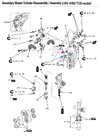I've owned one ST1100 ABS and my brother currently has one. It was one of the first jobs that I had to do on my 1100A. Brother had locked brakes and I sorted his out this year in January. New pistons and seals all round, new pads and that linkage was frozen solid. The Pin#11 would not budge, and the washer for the split pin were all seized in place. I brought it home to work on in my garage. I could not move that bow shaped bracket in relation to the pivot casting with the bearings #12 - except by clamaping it in a vice and slowly levering it back and forth.
It is hidden behind that grey shroud and tends to go unnoticed. The needle roller bearings are fine - protected by oil seals. The central pivot point, as
@Bloxham said - it is the clevis pin - part #11, the washer on the rear and the split pin part #10 that rust together and lock the entire assembly solid.
It is no coincidence that Bloxam, my brother and me all ride roads in the UK.

It had been a long time since I worked on an ST1100. I took this diagram and coloured in the parts that fit together - because it is not that easy to work out when it is all in pieces.
The pink bits fit together, the mauve bits go together. The blue and red arrows help to get things aligned too.
The attachment below is a full A4 size drawing.
Incidentally, another cause for the rear wheel lock up turned out to be the rear pedal - the lever shaft had become corroded in the hole in the alloy 'step'. So althought the pedal moved, the spring was inadeqaute to overcome the resistance of the corrosion. So that had to come out, get cleaned up, greased and put back. (I'd gone armed with new spring and circlip. They weren't needed but I replaced them anyway)


